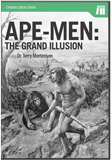
Thinking Critically About “Ape-Man” Messages
“Four-million-year-old fossil offers proof of human evolution!” Messages like these often appear in headlines, textbooks, and museums. Here’s how to sort through such claims with biblical, critical thinking.
Rare 10-million-year-old fossil unearths new view of human evolution.
“Little Foot” skull reveals how human ancestor more than 3 million years old lived.
Long-awaited research on a 4.4-million-year-old hominid sheds new light on last common ancestor.
These are real headlines from science news websites, echoing the familiar story that millions of years ago, populations of apelike ancestors (hominids) gave rise to humans. What are biblically minded Christians to make of such messages? Here’s how you can use 7 Checks of Critical Thinking to reach a biblical, logical conclusion about any “ape-man” claim.
1: Check Scripture.
The first way to detect a lie is by comparing it to the truth, with the ultimate standard for truth being God’s Word.1 Hominid claims fail this test because Genesis reveals God created living things according to their kinds and fashioned humans in his image, beginning with Adam.
2: Check the Challenge.
Do hominid claims challenge foundational doctrines of Scripture? To find out, we can examine what happens if we try to wrangle evolutionary human ancestors into the Bible. Because fossils represent dead things, interpreting apelike fossils as human ancestors entails assuming death occurred in God’s very good creation2 before human sin, contrary to Scripture. This not only undercuts biblical authority but also falsely portrays God as the author of death.
Moreover, attempts to accommodate hominids by dismissing a literal Adam undermine the gospel. They contradict the history in which the gospel is rooted, which records that a real Adam committed real sin leading to real death for all humans. As 1 Corinthians 15 affirms, this history explains why Jesus died a real death to pay for human sin. So, the question of human origins is a foundational issue.
Moreover, attempts to accommodate hominids by dismissing a literal Adam undermine the gospel. They contradict the history in which the gospel is rooted, which records that a real Adam committed real sin leading to real death for all humans.
3: Check the Source.
The next step is considering the source from which a hominid message originated. Generally, the most credible human sources are experts in a relevant field. But even experts, being human, are biased by their worldviews.3 Because the idea of ape-like human ancestors is incompatible with Scripture, hominid claims must stem from sources that make human reasoning, not God’s Word, their authority. This will affect their interpretations of fossils—a point worth remembering for Check #6 below.
4: Check the Definitions.
Do any terms in hominid claims need clarifying? Many such claims rest on (real or imagined) similarities between ape-like fossils and human skeletons. So, when we encounter broad claims that a fossil shows certain “human-like” features, it’s worth clarifying what seems “human-like” about them.
For instance, the supposed hominid Australopithecus sediba was said to exhibit “a very modern, developed hand with long thumbs, like in humans.”4 But as this article by Dr. David Menton, Dr. Andrew A. Snelling, and Dr. Elizabeth Mitchell clarifies, “the hand is not at all like a human hand. The thumb is proportionately much too long and the fingers too short . . . the hand is actually quite nicely suited for arboreal life.”
5: Check for Propaganda.
Notably, not all “human-like” features depicted in hominids are evident from the actual fossils. For example, artistic reconstructions of ape-like fossils often portray the apes with soulful human eyes showing whites around the irises, unlike the eyes of living apes. But researchers can’t gaze into a fossil’s eyeball sockets and divine the creature’s eye coloring. So, such humanized (or should I say, human-eyes-ed) depictions of ape fossils are not fact, but propaganda—a form of communication that primarily persuades using means besides logic and truth.
To catch other propaganda in hominid claims, you can apply the critical thinking hack of asking, “Is this message true because . . . ?” For instance, are hominid claims true because many people believe them, they’re repeated often from authoritative sources, or they’re presented artfully? Not necessarily. Saying so would involve logical errors known as fallacies of irrelevant premises.
6: Check the Interpretations.
What parts of a hominid message are facts, and which are interpretations? To find out, you can ask the following questions:
-
What’s the observational science?
What facts about “hominids” can we observe in the present? You might say that the bare-boned facts are the fossil fragments themselves and the rocks in which they were discovered. We can describe fossils’ appearances, compare them to other creatures’ skeletons, and measure the current radioisotope ratios in rocks from the dig sites. All this is observational science.5 (Incidentally, however, extremely few researchers have an opportunity to observe original “hominid” fossils firsthand.6)
What’s the historical science?
When it comes to hominids, observational science doesn’t usually give researchers many facts to work with because “hominid” skeletons are not only rare but also frequently incomplete, known only from a few fragments or teeth. That’s where historical science takes over, which involves interpreting facts observed in the present based on assumptions about the past. Researchers’ ideas about missing bones, portions of bones, and soft tissue absent from hominid fossils are all interpretations from historical science. The term “hominid” itself is also an interpretation, involving a claim about the unobservable past.
What assumptions are involved?
You can recognize many historical science interpretations by words like “may,” “probably,” and “could,” which signal a possible explanation rather than an observable fact.
You can recognize many historical science interpretations by words like may, probably, and could, which signal a possible explanation rather than an observable fact. Some interpretations, however, may be more subtle, involving layers of assumptions presented as fact. For instance, researchers who assumed that Au. sebida fossils represented hominids en route to evolving bipedalism reconstructed missing portions of the fossils’ pelvises based on those evolutionary assumptions. The resulting reconstructions may be touted as facts “proving” the animals walked partially upright, but they’re really assumptions.
Along with making specific assumptions about human ancestry, hominid messages assume earth is millions of years old and one kind of creature can evolve into another. These assumptions have serious issues which you can learn through articles on the age of the earth, radiometric dating, information theory, mutation, and natural selection.
What’s a biblical explanation?
Instead of using evolutionary assumptions, how might researchers view “hominid” fossils through a biblical lens? Because Scripture indicates God created humans separately from ape-like animals, we’d biblically predict that most “hominids” are either extinct apes or fully human. So, as Dr. Menton explains in his presentation, Three Ways to Make an Ape-Man,7 hominid messages usually involve one of three scenarios:
- Making an ancient ape appear human-like.
- Making a post-flood human appear ape-like.
- Combining human and ape bones to create a chimera, as happened in the Piltdown Man hoax.
What’s the rest of the story?
When we look closer at the observational science of “hominid” fossils, we generally find that the facts are indeed consistent with one of these three scenarios. For instance, a careful examination of the famous Au. afarensis specimen “Lucy” reveals that Lucy’s anatomy is consistent with that of an ape. Observations from paleontology and genetics, meanwhile, confirm that Neanderthals—although classically caricaturized as apish brutes—were fully human.8
7: Check the Logic.
What final logical errors might hominid messages contain? An especially common one occurs in arguments that claim that fossils “prove” evolutionary origins:
- If humans evolved from ape-like ancestors, then we should find similarities between human skeletons and ape-like fossils.
- We do find similarities between human skeletons and ape-like fossils.
- Therefore, humans evolved from ape-like ancestors.
This is a fallacy called affirming the consequent. We can see why such arguments are fallacious by creating another argument with the same structure:
- If the car is out of gas, then it won’t start.
- The car won’t start.
- Therefore, the car is out of gas.
There could be many reasons why an engine doesn’t start, so failure to start is not itself proof that a car needs fuel. Likewise, common ancestry is not the only reason why humans and fossil apes may share similar features. For example, a biblical explanation states that similar features reveal apes and humans share the same Designer who engineered useful designs which apply across multiple creatures. Opposable thumbs, for instance, come in “handy” both for humans suited to life in a garden and for apes engineered to swing through the trees.
Rethinking the Headlines
Ultimately, a little biblical critical thinking reveals that, when headlines declare a fossil represents a human ancestor from millions of years ago, neither the human ancestor nor millions of years claims are observable facts. Rather, they’re historical interpretations built on faulty evolutionary assumptions. However, a biblical explanation that the fossil represents a post-flood human or extinct ape will likely be more consistent with the observational facts. That’s why creationists are unsurprised to see “updates” like the following headlines from science news websites:
Human ancestor 'Lucy' was a tree climber, new evidence suggests.
Our supposed earliest human relative may have walked on four legs.
Earliest hominid: Not a hominid at all?
Unlike science headlines, God’s word does not require updating. And God’s Word reveals that we are not animal by-products of evolutionary happenstance but persons with a purpose, created in the image of a Designer who loves us. Now that’s news worth sharing!
Thinking Critically About a Real “Ape-Man” Article
Try applying the steps of Check #6 to the paragraphs below from a recent science news story. Then, you can check your analysis by scrolling down to see the example answer.
New Fossil Reveals Face of Oldest Known 'Lucy' Relative
Excerpt:
The hominin's face was not quite as massive or as rugged as Lucy's, but it was still robust, the researchers reported today (Aug. 28) in the journal Nature. The canine teeth were smaller than those of earlier hominids but larger than those of A. afarensis like Lucy. The lower jaw protruded, ape-like. That's far different from the relatively flat faces of modern humans and other species of the genus Homo, which first evolved around 2.8 million years ago.
The big bones of australopithecines probably evolved to help these human ancestors chew rough foods, study co-author Stephanie Melillo, a paleoanthropologist at the Max Planck Institute for Evolutionary Anthropology in Germany, said at the news conference. The more delicate faces of the genus Homo probably evolved as human ancestors moved to more-open grassland habitats and started incorporating meat into their diets, thereby fueling bigger brains and lessening the need to chew, Haile-Selassie said.
Example analysis:
- Facts from observational science are underlined.
- Interpretations from historical science are bold and italicized. (Notice the assumptions involved.)
- “Red flag” words that signal historical interpretations are in bold.
For details about an alternative, biblical explanation of related fossils, see the resources listed below.
The hominin's face was not quite as massive or as rugged as Lucy's, but it was still robust, the researchers reported today (Aug. 28) in the journal Nature. The canine teeth were smaller than those of earlier hominids but larger than those of A. afarensis like Lucy. The lower jaw protruded, ape-like. That's far different from the relatively flat faces of modern humans and other species9 of the genus Homo, which first evolved around 2.8 million years ago.
The big bones of australopithecines probably evolved to help these human ancestors chew rough foods, study co-author Stephanie Melillo, a paleoanthropologist at the Max Planck Institute for Evolutionary Anthropology in Germany, said at the news conference. The more delicate faces of the genus Homo probably evolved as human ancestors moved to more-open grassland habitats and started incorporating meat into their diets, thereby fueling bigger brains and lessening the need to chew, Haile-Selassie said.
Resources for Further Information:
Articles:
Online book chapters
Answers.TV
Footnotes
- Is it circular reasoning for Christians to compare messages against Scripture? No: to find out why not, see Critical Thinking Scan Episodes 36, 37, and the associated resources.
- Genesis 1:31.
- The prestige associated with discovering a “human ancestor” may additionally pressure or motivate researchers to interpret fossils as hominids, as Dr. Menton describes in this book chapter.
- Science Daily, “Direct ancestor of Homo genus? Fossils show human-like hand, brain and pelvis in early hominin,” September 8, 2011, https://www.sciencedaily.com/releases/2011/09/110908161446.htm.
- For more information on why the distinction between observational and historical science is valid, see Troy Lacey, “First Use of Origins vs. Operational Science,” Answers in Depth 13 (2018), https://answersingenesis.org/what-is-science/first-usage-origins-vs-operational-science/.
- Dr. David Menton, “Did Humans Really Evolve from Apelike Creatures?” In The New Answers Book 2 (Green Forest, AR: Master Books, 2008), https://answersingenesis.org/human-evolution/ape-man/did-humans-really-evolve-from-apelike-creatures/.
- Available on Answers.TV, https://www.answers.tv/three-ways-to-make-an-ape-man.
- One day, while hearing an evolutionary interpretation of Neanderthals in a physical anthropology class, I raised my hand and asked the professor, “If Neanderthals were alive today and somebody killed one, do you think that person should be charged with murder?” The professor paused to consider, then conceded that murder would be an appropriate charge, illustrating that Neanderthals are recognizable to evolutionists as possessing ethical personhood.
- Check the rest of the story: other facts from observational science suggest that members of the genus Homo like Neanderthals and humans interbred, so biologically, there are no separate “species” within humankind. This is consistent with the biblical revelation that God created all people groups from “one blood” (Acts 17:26).
Recommended Resources

Answers in Genesis is an apologetics ministry, dedicated to helping Christians defend their faith and proclaim the good news of Jesus Christ.
- Customer Service 800.778.3390
- © 2024 Answers in Genesis





